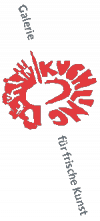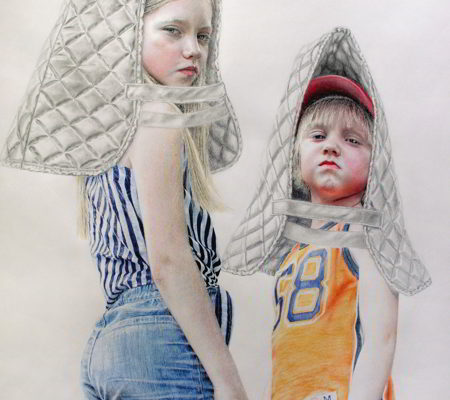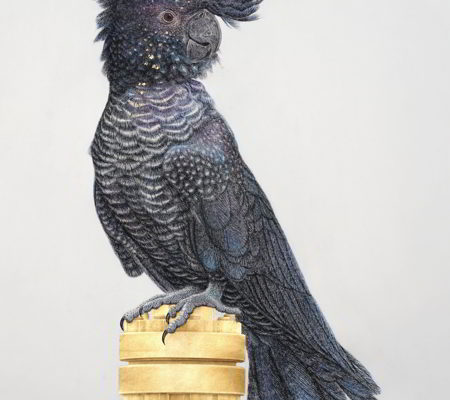Galerie Kuchling presents Svenja Schüffler‘s first comprehensive solo show in Germany. Titled How to manage the Apocalypse? the gallery shows works from her latest projects and from the namesake cycle of works.
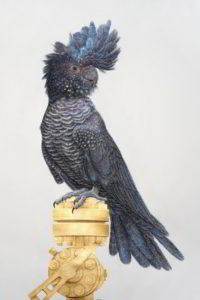
Svenja Schüffler • Pitch Bird ‘2. 2019 • Chalk pastels on paper, ink on gold leaf. 80 x 60 cm (detail)
Her latest accomplishments show a vast range of graphic techniques on paper that Svenja Schüffler prepared and expanded especially for this work group. With great mastery the artist combines traditional skills like gilding, frottage printing and oil-based paper dye technique with modern techniques like airbrush stencil works and a scratch technique under pastel chalks that she had conceived herself. In terms of their great focus on detail and precision, these scratched pastel chalk drawings are characteristic of Svenja Schüffler‘s artistic creation. They are the result of a meticulous work process with a magnifying glass that may take up to a few weeks or even months. This way extremely striking studies of human and beastly compositions come into existence. To her late works the artist added letters and typography as creative elements, conceiving them as commentary and headers, or arranged in form of allegories.
With regards to content, her works correspond with her essay “How to manage the Apocalypse?“. It will be presented in the exhibition as part of an artist book. Visitors are also invited to take a copy of it home. Different readings of essay and pictures reflect and inspire each other.
Both aesthetically and literarily, the project poses the question: “How to manage?“, and explores whether management in a high-tech civilization significantly fueled by fossil carbon follows this glorifying logic: Safeguarding energy supplies and technology projects takes absolute precedence over the accompanying side effects. Wouldn‘t that mean, that undesired consequences don‘t require prevention but just control, so to speak management? There seems to be no just basis for a belief that sees disasters and undesired consequences as things that can be managed, because the limits of insurability, that is the increasing lack of private insurance, suggests uncontrollable and incomputable insecurities and technological risks on a global scale.
A non-contestable justification is generated to raise alarm. “How to manage the Apocalypse?“ investigates into the issue of how a new method of talking about the end can be attained, one that names the catastrophe loud and clear, in order to prevent it. Both in the exhibition and in her essay Svenja Schüffler explores this question with a thought experiment and the conception of a ‘School of Early Warning’ that cautions the end of all guarantee.
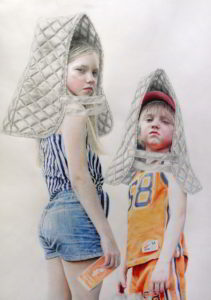
Svenja Schüffler • An Experiment under a Concrete Slab. 2016 • Chalk pastels on paper 200 x 152 cm (detail)
With An Experiment on a Bird (2016) and Anthropomorpha (2013) two drawing projects on earthquake risks and the line between man and animal will be showcased in separate gallery rooms. These projects also reflect the artist‘s approach to questions of uncertainty. Confrontation with and the experience of uncertainty and unsecured knowledge in science that Svenja Schüffler brings with her from her studies of geology and geo-information science, provide the starting point of her artistic career and give direction to her focus on science, technology and the Earth, as well as on the uncertainty of knowledge.
Svenja Schüffler is co-founder of the Institute for Uncertain Knowledge (IUK), which approaches the phenomenon of “Uncertain Knowledge“ in science and society from an artistic angle, and produces knowledge about uncertainty.
With the support of the German Research Centre for Geosciences GFZ in Potsdam, the artist presented a multimedia-based concept of a real-time simulation of the earthquake risk in Istanbul at the Forecast Forum at the Berlin Haus der Kulturen der Welt (“House of the World’s Cultures”) in 2015. In 2016, the artist took also part in the Anthropocene Curriculum at the HKW. Just a few weeks ago several works by Svenja Schüffler were included in the anniversary exhibition “Experiment Zukunft“ at the Kunsthalle Rostock and will now be on display at Galerie Kuchling. After long-term stays in Cuba and in Spain, Svenja Schüffler has been living and working in Berlin since 2011.
Translation: A. Liebhold, Photos: A. Bondar
